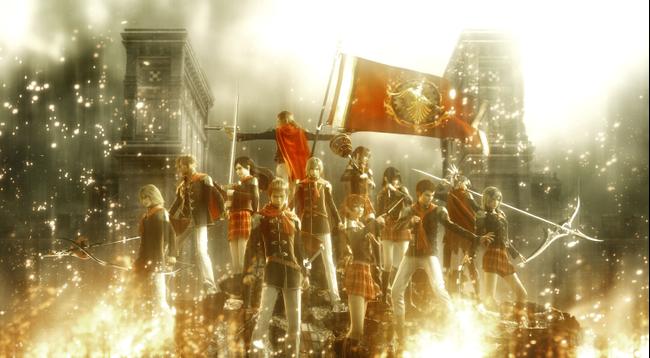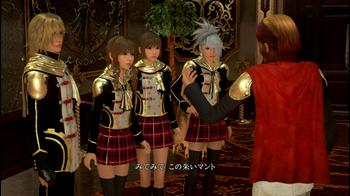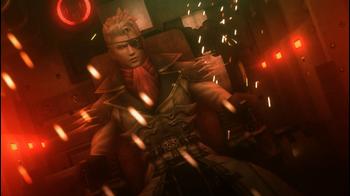Final Fantasy Type-0 HD Review
There’s a lot to say about Final Fantasy Type-0 HD. Trapped in Japan for years, the game has finally made its way over to fans in the west. Although it’s not quite the portable release many had hoped for its big screen conversion is nothing to scoff at – rather it’s a welcome return to a game some have already played and a brand-new opportunity for those who haven’t.
When I say there’s a lot to talk about with Type-0 HD, I mean it. The game has undergone quite a few changes from when I played the original release back in 2011. Brought to Western shores under the HD remaster banner, Type-0 HD is exactly that. It’s not a remake nor a quick port – it’s an HD remaster put through some additional paces along the road to current generation consoles. That in itself isn’t a negative, mind. For all intents and purposes Final Fantasy Type-0 is still the same game I fell in love with so long ago.

Final Fantasy Type-0 has always represented a bold direction for the series. Birthed on the PlayStation Portable, the game is helmed by now-Final Fantasy XV director Hajime Tabata, who sought to break the boundaries of the series by telling a dark war story.
Story wasn’t the only change Tabata was interested in. Branching off from Crisis Core: Final Fantasy VII he envisioned a unique action-based battle system as the core of his game and ultimately the most satisfying aspect. Simply watching Type-0 in action isn’t enough – you have to play it to believe it.
For the most part, battles take place within the context of the same zone your characters are already in. The exception to this rule comes on the game’s world map which – like FF games of old – transports you into random battles held on separate screens. Your characters can move about the battlefield freely. One of three playable characters in your party can execute actions with the touch of any of the controller’s four face buttons with movement controlled by the analog stick. It’s an action game through and through.
Type-0 introduces its own unique spin on the action RPG battle system as well. Adding to the high-octane attacks be they physical or magic damage-dealing is an ability that triggers on enemies called Kill Sight and Break Sight.
Red icons, in the case of Kill Sight and yellow icons for Break Sight can randomly appear above enemies in certain conditions allowing you to strike with a killing blow or deal a huge burst of damage respectively.
There are virtually no limits to Type-0’s battle system, although you’ll be managing stats like HP and MP per typical RPG mechanics. MP in particular can drain pretty fast, so it’s important to balance the use of magic abilities during longer fights.
Should you fall in battle, however, you don’t have to worry too much. In addition to having the ability to switch between your other party members at will, you’ll also be drawing from a stack of reserve members as well. Type-0 is unique in that it allows the player to control 14 characters, each with their own weapons, experience pools and skill sets.
At the outset of the game, encounters can be fairly tough. Truth told, the game opens with little in way of direction and your left wondering what to do when faced with an early boss. Unlike the recent FF13 series, HP and other stats do not reset after each battle unless you’re on the world map. Instead, you’re pushed to be careful and the challenge of battle becomes real as you struggle to stay alive in sometimes dire situations. The difficulty in this game – even at the easiest setting – is brutal.
That isn’t to say you can’t overcome Type-0’s difficulty curve. Level your characters appropriately and stack them with abilities can give you an edge in fights where you outclass the enemy’s own level. Should you charge into battle under leveled and ill prepared, however, you’re going to have to rely on precise dodging, attacks and appropriate reactions to survive. In a way it creates a bit of depth for those who really want a challenge.
By the time you’ve unlocked enough skills through normal battle experience accumulation and equipped your characters with new gear you’ll find that it’s the game’s combat that keeps on giving. Simply put, Type-0’s battles are really fun.
Beyond Type-0’s battle system lies the skeleton of PSP limitations. The way the game’s mission and overall world structure is still beholden to the design choices of the original and in the HD version it really shows. It’s clear in many respects that Type-0 is still a portable experience on a bigger screen.
Final Fantasy Type-0 has a world map – let’s be clear about that. The bulk of the game branches out from a central hub location known as Akademeia. It’s here you’ll be spending a lot of time in-between missions, taking on quests, talking to NPCs and other matters. Following missions – which tend to involve the advancement of the main story – you’re put on a time limit on the bottom of the screen that tells you the length until your next outing. It’s up to you to decide what to do with that time.
This sort of structure was acceptable on PSP because of its pick-up-and play nature and in the HD version it does work for what it is – but it ultimately was designed with those portable limitations in mind and as a result leaves us wondering what could have been if Square Enix had taken the time to do a little re-working.
Of course, one could argue that Type-0’s setup is all very procedural. You’re given clear direction on how to spend your time and where to go next and missions don’t stretch on needlessly as well. The side stuff in general is nothing to write home about – often consisting of typical fetch quests or other RPG fodder – but they do offer something different, even if the allure lasts for a limited amount of time.
One of the things that hasn’t changed in the HD conversion is Type-0’s story. Four years on, I found it equally endearing as I did back then – even though I’ve seen it all before.
The narrative is different than your usual FF faire – following an elite combat squad known as Class Zero, the player is introduced to the vast world of Orience and its four nations struggling to protect the power of crystals. Class Zero is forced to mobilize when the Militesi Empre breaks the standing peace agreement and it becomes up to them to infiltrate and discover the lies and truths of war.
It’s simple enough, but many of the little twists and turns throughout the game’s eight chapters can be a bit much to understand. The truth is, you’ll need to play the game at least thrice over to get a clear picture of what’s going on as your first will undoubtedly lead to more questions than answers. Without spoiling too much, the game offers alternate scenes and missions that show you what off-screen characters were doing behind the scenes while filling in a lot of the initial blanks. It’s an interesting setup and I have to hand it to Tabata for throwing in that extra bit of replay value, even if certain story notes do feel rushed in the end.
One thing I wanted to mention with regards to the HD version is the stylistic changes that occurred during the conversion.
Gone is the red filter and unified art style of the original and in its place a visual experience that is for better or worse uneven. There’s no doubt the upgrade here is substantial but on closer inspection it’s clear the game’s PSP roots are still there.
To give you an example, Square Enix has gone and updated the characters models for all of the playable main characters. They now look like something you might expect from PS4-level architecture, even if their animations are a bit stiff. The problem though, is NPCs weren’t lucky enough to make a cut and the result is nothing but jarring when you’ve got your shiny new character model emoting to one clearly stuck in the PSP era.
It’s the environments too that sort of stick out. At first glance they look nice – with a brand new lighting system in place comparable to that found in the upcoming FF15. On closer inspection, however, it’s clear we’re still looking at low-poly geometry albeit with a fresh coat of paint.
The biggest offender in all this though is the game’s camera. Trying to change it was a good idea, but the result is often dreadful. Even the slightest twitch of the analog stick sends the camera around in a blurred flurry – enough to dizzy even the most grounded person. If anything, it’s distracting and one wonders why Square Enix neglected to include options to adjust the thing outside of the usual inversion tick. I was able to get used to it after a time, but to call it good is anything but.
Coming back to Final Fantasy Type-0 has certainly been the interesting experience. Its concepts and story are unique and hold up four years on, despite the visual inconsistencies of the HD version. It would have been nice to see things like the world structure and camera retooled further, but it’s clear the game wasn’t given that luxury.
These ideas are certainly the products of portable limitations, but in the end they fail to stifle what is in truth a compelling experience.


